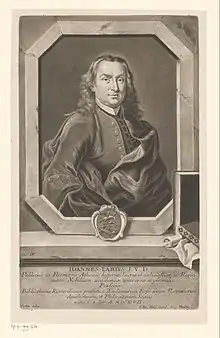Giovanni Lami
Giovanni Lami (1697–1770) was an Italian jurist, Church historian, and antiquarian.


He was born at Santa Croce sull'Arno (between Pisa and Florence) on 8 November 1697, into a wealthy family. From 1715 he studied Law at the University of Pisa and obtained his doctorate of law in 1719.
From 1728 he was the librarian of the Biblioteca Pallavicini at Genoa and (after extensive travels) in 1732 became librarian to the wealthy Riccardi family in Florence. He eventually succeeded to a professorship of ecclesiastical history at the University of Florence, and was a court theologian and counsellor to the Grand Duke of Tuscany. He died in 1770 and was buried in the Basilica di Santa Croce. His magnum opus was the eighteen-volume Deliciae eruditorum, a "hodge-podge of antiquarian lore" published over a span of decades at Florence.[1] Lami was the first to describe the Byzantine manuscripts Minuscule 201, Minuscule 362, and Minuscule 370. He also wrote a Memorabilia, dedicated to the illustrious men of his time, and many other works of history and philology.
He died alone at home in Florence on 6 February 1770 and is buried in the church of Santa Croce, Florence. His huge monument, erected in 1772, lies on the south wall close to Galileo and opposite Michelangelo. His Latinised epitaph gives his name as Iovanni Lamio.
Works
- Deliciae eruditorum, Florence, 1736–69.
- De eruditione Apostolorum, Florence, 1738.
- Lezioni di antichità toscane, Florence, 1766.
Notes
- Ephraim Emerton (1923), "Altopascio—A Forgotten Order," American Historical Review, 29(1), 3.